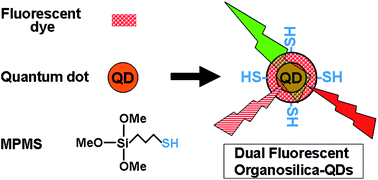One-pot synthesis and characterization of dual fluorescent thiol-organosilica nanoparticles as non-photoblinking quantum dots and their applications for biological imaging
Abstract
A multifunctional

* Corresponding authors
a
Department of Anatomy and Cell Biology, University of Tokushima Graduate School of Medical Sciences, 3-18-15 Kuramoto, Tokushima, Japan
E-mail:
michy@basic.med.tokushima-u.ac.jp
Fax: +81-88-633-9426
Tel: +81-88-633-9220
b Department of Medicine and Bioregulatory Sciences, University of Tokushima Graduate School of Medical Sciences, Tokushima, Japan
A multifunctional

 Please wait while we load your content...
Something went wrong. Try again?
Please wait while we load your content...
Something went wrong. Try again?
M. Nakamura, S. Ozaki, M. Abe, T. Matsumoto and K. Ishimura, J. Mater. Chem., 2011, 21, 4689 DOI: 10.1039/C0JM04259E
To request permission to reproduce material from this article, please go to the Copyright Clearance Center request page.
If you are an author contributing to an RSC publication, you do not need to request permission provided correct acknowledgement is given.
If you are the author of this article, you do not need to request permission to reproduce figures and diagrams provided correct acknowledgement is given. If you want to reproduce the whole article in a third-party publication (excluding your thesis/dissertation for which permission is not required) please go to the Copyright Clearance Center request page.
Read more about how to correctly acknowledge RSC content.
 Fetching data from CrossRef.
Fetching data from CrossRef.
This may take some time to load.
Loading related content
